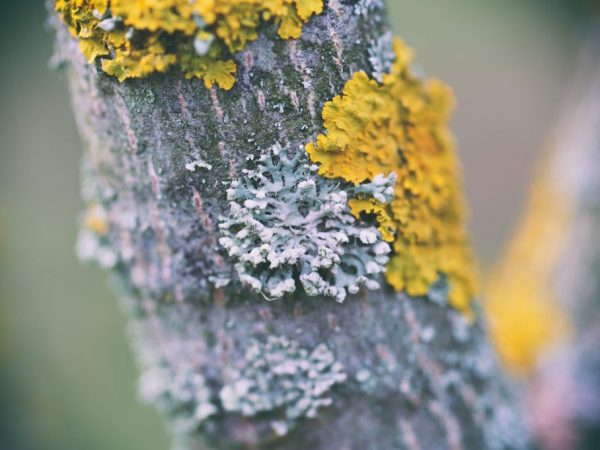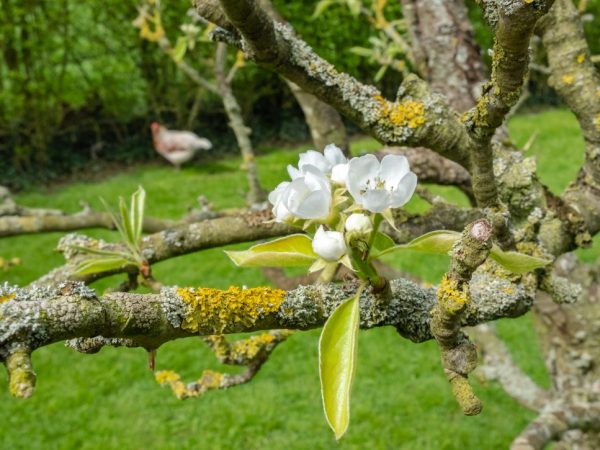Signs of lichen on an apple tree and methods of treatment
Lichen on an apple tree is a dangerous disease. It can occur in the absence of proper pruning: the crown becomes too thickened, the ventilation process is disrupted. This pathology provokes cracking of the bark on the trunk and branches, as a result of which the tree becomes weak and is quickly affected by various types of infections.

Signs of lichen on an apple tree and methods of treatment
Based on this, you need to start treating the diseased plant as soon as possible. Let's consider everything in order.
Signs of appearance
First, a greenish bloom appears on the bark, which is formed by unicellular algae - moss. Then a fungus appears on its surface, causing cracking of the bark. Fungal growths have a yellowish brown tint.
In conditions of high humidity and lack of good lighting, the fungal infection multiplies rapidly and can remain viable for many years.
Several varieties can settle on one tree at once.
It is easy to spot such growths in damp weather - during a period of high humidity, their color is especially bright and, depending on the type of lichen, it can be greenish, bright yellow, salad or brown.
Causes
Many gardeners believe that lichen appears mainly on old trees, but this is a misconception, the appearance of growths on young apple trees is also not uncommon.
There are several reasons for the appearance:
- thickening of the crown;
- small cracks in the bark, from which juice flows out and creates an optimal moist environment for microorganisms;
- excessive moisture in the garden;
- weakened and depleted root system of the tree;
- freezing of wood, getting severe sunburn.
The trunk, covered with a dense green layer, no longer gains access to oxygen, and harmful insects, viral or bacterial infections appear in the affected areas.
At the first signs of the appearance of a lichen on an apple tree, urgent measures must be taken to save the tree.
Views
There are several types of lichen. All of them cause great harm to the tree and, over time, can lead to its death.
Xanthoria wall or zolotyanka

Goldberry grows very slowly
Orange or golden lichen belongs to the foliose varieties. In a shaded area, it has a pale green color. This species develops very slowly - the annual growth is only 1 mm.
Scale (crustal)
This type of lichen is attached to any hard surface, incl. and to the bark of trees. Sometimes they can develop inside the soil and have a color that is imperceptible to the naked eye - light or dark brown.
Bushy
It has numerous branches of a round or flat shape, collected in bushes. They grow on living wood or its remains in the form of hanging outgrowths. They can develop in the ground.
Leafy
Lamellar or leaf lichen of various sizes and shapes, mainly spreading in breadth.Attaches to the surface of the bark due to the lower cortical layer. Has a greenish or yellowish-green tint.
Treatment methods
- Treatment of affected organs with iron sulfate - the optimal concentration is 3-5%. For treatment to be effective, you first need to remove the damaged tissue with a brush. Spraying is carried out in early spring - before the start of sap flow. After a week, the lichens will disappear on their own. In case of severe damage, trees are treated with a highly concentrated solution of ferrous sulfate (7-10%), and all branches that are completely covered with moss and lichen are cut out and burned.
- An ash-and-soap solution is used to fight. This tool is used to coat the trunks and the near-trunk zone of trees. To prepare it, you will need to grind 1 piece of laundry soap into small pieces, mix with salt (0.5 kg), ash (1 kg), pour hot water (10 l), stir well until completely dissolved and coat the trunks with the resulting mixture.
- Fight against lichen, especially resistant to various antifungal agents, helps the drug Skor. First you need to remove the affected tissue, then treat it with a chemical agent. The best time for treatment is the beginning of the growing season. If necessary, re-irrigate ten days after the first spraying.
- No less effective is the double treatment of trees with copper sulfate. A specific composition is used with each spraying. For primary pollination, a mixture of copper sulfate with lime is used - 300 g of each component per 10 liters of water. After two days of infusion, the solution is boiled for 40 minutes, then brought to a volume of 20 liters with water. For secondary spraying, 100 g of lime, 100 g of vitriol and 10 liters of water are used, insisted for two days, boiled for half an hour, then used for processing. The spraying interval is 10 days.
- Bordeaux mixture. It is necessary to use a weakly concentrated solution in order to avoid burning the tissues cleaned of growths - 50 g of powdered copper sulfate and 200 g of lime powder are consumed per bucket of water. The solution is thoroughly stirred until the ingredients are completely dissolved and used to irrigate the crown.
- Slaked lime solution with sulfur. It is necessary to take 600 g of slaked lime mushy, dissolve in 0.5 liters of boiling water. Put on low heat and gradually add 400 g of sulfur powder while stirring. Add another 1.5 liters of water to this mixture and boil under a closed lid for 15 minutes. It turns out a broth of saturated red color. It is cooled to a temperature of 37 °, poured into a glass sealed vessel. To treat trees, use 100 ml of the substance per 5 liters of water. For greater effect, a little machine oil is added to the solution, which covers the chemical with a film and prevents the fungus from developing further.
- Soda ash (100 g) will help get rid of moss and lichen, dissolve it in 20 liters of water, add 80 g of crushed laundry soap. The affected areas on trees must first be cleaned, then treated 2 times at intervals of 7 days. It is good to treat with such a remedy on a cloudy day when there is no rain or wind, otherwise the drug has a bad effect on pathogenic microflora.
Additional measures

All infected areas must be cleaned before processing.
After each treatment, the trees are whitewashed with hydrated lime to protect them from the appearance of lichens and various parasites.
For cooking, use lumpy lime, which is quenched two hours before whitewashing. For processing trunks, fluff, lime adze or milk are suitable.
- The fluff is prepared as follows - 5 kg of powdered lime are dissolved in a bucket of water. One hour after the chemical reaction, the thick solution is ready for use.
- To prepare the dough, you will need water and lime (1.5: 1).
- Lime milk turns out to be weakly concentrated - water is mixed with a powder substance (3: 1).
Spraying is carried out several times at intervals of 10 days.
To prevent the appearance of lichen on the trunks and shoots, the crown can be treated with a urea solution: 700 g of the substance is dissolved in a bucket of water.
Before processing, the trunks must be cleaned of moss and lichen. For complete destruction, treatment takes place in two stages with a frequency of 10 days. The same tool is used to treat trees in spring and autumn in order to prevent the appearance of pathogenic microflora on wood.
Preventive actions
It should be remembered that moss or lichen never appears on healthy and dry branches. Therefore, all preventive measures are aimed at preserving the integrity of the bark and wood.
- Regular treatment of the crown of a tree from various sores and parasites that damage the bark with copper-containing preparations (copper sulfate or Bordeaux mixture).
- Annual application of complex fertilizers (nitrogen, phosphorus and potash), which increase the tree's immunity from diseases and frost.
- Sanitary pruning of the crown in the spring and fall, which will help prevent infection of the bark on the branches and trunk. All cut sites are treated with a disinfectant and covered with garden varnish.
- Whitewashing boles in autumn to prevent frostbite and bark burning in the sun.
Conclusion
It is very difficult to overcome moss on an apple tree, it is much easier to prevent its development, and for this a number of simple preventive measures should be followed.
In case of damage, the tree can be saved if the treatment is carried out in time with one of the above drugs. The main thing is to follow the treatment regimen and dosage.

